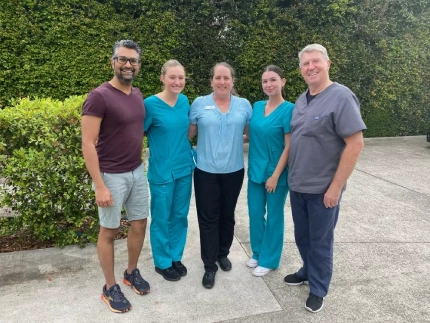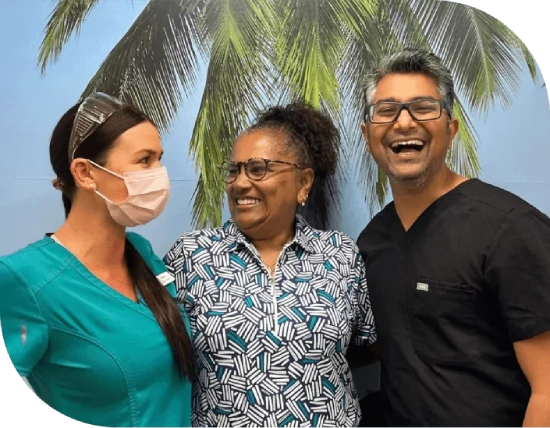
Bli Bli Dentist
We’re a long-standing clinic providing expert
dental care for over two decades.


Explore Family-Friendly Dental Care at The Smile Workx
At The Smile Workx, we’re dedicated to offering gentle, holistic dental care.
Our team is committed to providing a soothing and comprehensive treatment experience for every patient.
Situated at 48 Mary Street in Noosaville, our clinic boasts convenient off-road parking and is fully equipped with wheelchair access, ensuring all patients can visit us with ease.
Our array of services spans from basic dental health checks to advanced cosmetic procedures, all under one roof. We ensure every family member leaves with a brighter smile.
Our approach blends modern techniques with compassion, ensuring comfortable dental visits for all.
Our Special Offers

Check-up & Clean $62.25/week* or $249
⚫ Scale & Clean
⚫ Gum Health Assessment
⚫ Refreshing Fluoride
⚫ New patient hygiene gift
⚫ New patients Only
Health fund rebates available!
⚫ All x-rays included

Kids Specials $0 out of pocket
⚫ GAP FREE for Under 14 years old, health fund members
⚫ Comprehensive Exam and Consultation
⚫ Scale & Clean with X Rays
⚫ Gum Health Assessment
⚫ Refreshing Fluoride

Dental Implants $35/week*
⚫ Complimentary Consultation (Savings of $55)
⚫ Celebratory post treatment gift: Water Air Flosser (valued at $99)
⚫ New Patient Hygiene Gift
⚫ Flexible payment plans

Orthodontics $83/week*
⚫ Complimentary Smile Consultation
⚫ Bonus gift: Custom retainers (valued at $500)
⚫ Celebratory Gift: Professional Whitening Kit (savings of $460)
⚫ New Patient Hygiene Kit

Smile Makeover Package $87.50*/week
⚫ High Quality-Natural Looking Veneers
⚫ Celebratory Post Treatment Gift - Professional Smile Portraits
⚫ New Patient Hygiene Gift

Custom Sports Mouthguards GAP-FREE or $100
⚫ Highly Durable and Comfortable
⚫ Pick your child’s favourite colour!

Check-up & Clean $62.25/week* or $249
⚫ Scale & Clean
⚫ Gum Health Assessment
⚫ Refreshing Fluoride
⚫ New patient hygiene gift
⚫ New patients Only
Health fund rebates available!
⚫ All x-rays included

Kids Specials $0 out of pocket
⚫ GAP FREE for Under 14 years old, health fund members
⚫ Comprehensive Exam and Consultation
⚫ Scale & Clean with X Rays
⚫ Gum Health Assessment
⚫ Refreshing Fluoride

Dental Implants $35/week*
⚫ Complimentary Consultation (Savings of $55)
⚫ Celebratory post treatment gift: Water Air Flosser (valued at $99)
⚫ New Patient Hygiene Gift
⚫ Flexible payment plans

Orthodontics $83/week*
⚫ Complimentary Smile Consultation
⚫ Bonus gift: Custom retainers (valued at $500)
⚫ Celebratory Gift: Professional Whitening Kit (savings of $460)
⚫ New Patient Hygiene Kit

Smile Makeover Package $87.50*/week
⚫ High Quality-Natural Looking Veneers
⚫ Celebratory Post Treatment Gift - Professional Smile Portraits
⚫ New Patient Hygiene Gift

Custom Sports Mouthguards GAP-FREE or $100
⚫ Highly Durable and Comfortable
⚫ Pick your child’s favourite colour!
Why Choose Us?
Choosing our dental practice means selecting a team committed to delivering high-quality dental services with a personal touch. We recognise the importance of combining expert care with a gentle approach, and our team is passionate about assisting our patients to attain radiant, joyful smiles alongside optimal oral health.
In Noosaville, our reputation as trusted dental professionals stems from our dedication to providing superior dental care in an environment designed for relaxation and ease.
This commitment to excellence and patient comfort has resulted in a loyal patient base, with many individuals and families choosing to stay with us for years.
We recognise each patient’s distinct dental needs, from first-time young visitors to adults with complex histories. Our commitment is to provide customised, effective dental care tailored to every individual’s requirements.
Choose The Smile Workx for quality dental care
You can trust us for family-oriented care tailored to individual needs.
- Cost-effective, soothing, and thorough dental care available
- Inviting environment, perfect for family visits
- Advanced technology and progressive dental practices
- Highly skilled and experienced dental team
- Wide variety of dental treatment choices
- Adaptable payment plans to suit different budgets
- Provision for children's bulk billing
- Certified partners with BUPA, HCF, NIB, and WestFund
- Immediate assistance for urgent dental situations
- Customised scheduling for each patient's needs
- Premium aesthetic dental solutions provided
For more information on dental treatments and appointments, schedule an appointment with us at (07) 5300 2133.







Payment Plans Available
What Our Customers Say
Frequently Asked Questions
What is cosmetic dentistry?
Cosmetic dentistry encompasses dental procedures aimed at enhancing the appearance of one’s smile, surpassing the functional focus of general dentistry. This branch specifically targets aesthetic improvements such as teeth whitening to brighten discoloured teeth and dental veneers to correct issues like chips, gaps, or misshapen teeth. While general dentistry concentrates on oral health and preventive care, cosmetic dentistry focuses on improving cosmetic aspects to boost confidence and overall appearance.
How are dental implants placed?
Dental implants represent a significant advancement in restorative dentistry, offering a permanent solution for missing teeth. These implants serve as artificial roots, providing a strong foundation for fixed or removable replacement teeth that are made to match natural teeth. The process of placing dental implants is a form of oral surgery that requires careful planning and execution.
Initial Consultation and Planning
The first step in the dental implant process involves a comprehensive evaluation by a dental professional. This initial consultation typically includes dental X-rays and, possibly, 3D images, along with a thorough examination of the patient’s oral and overall health. This stage is crucial for planning the implant procedure, ensuring the patient is a suitable candidate, and customising the treatment to the patient’s specific needs.
Preparatory Procedures
Some patients may require preparatory procedures before the placement of dental implants. This could include treatments like bone grafting, where insufficient bone mass makes direct implant placement unfeasible. Bone grafting is designed to provide a solid base for the implant, and this procedure requires several months of healing before the implant can be placed.
Implant Placement
The actual implant placement is the next phase. This involves oral surgery where the dental implant, a titanium screw, is inserted into the jawbone under local anaesthesia. The screw will serve as the new tooth root and is placed directly into the location of the missing tooth. Post-surgery, there is a period of healing (osseointegration) where the implant integrates with the bone – a process that can take several months.
Abutment and Prosthesis Placement
Once the implant has bonded with the jawbone, an additional procedure might be needed to place the abutment, which will hold the new tooth. After the soft tissues heal around the abutment, impressions of the teeth are taken, which are used to create the crown, bridge, or denture that will be attached to the abutment. This part of the process is crucial for ensuring the new teeth look natural and fit comfortably within the mouth.
Aftercare and Maintenance
Following the placement of the final prosthesis, proper aftercare is vital. Regular dental check-ups, along with meticulous oral hygiene, are essential to ensure the longevity and success of dental implants. Patients are advised to treat their implants just like their natural teeth, with regular brushing and flossing. Any follow-up visits recommended by the dental practitioner should be adhered to ensure the health and functionality of the implants.
What is the procedure for performing root canal treatment?
Root canal treatment, also known as root canal therapy, is a dental service aimed at saving a tooth that has been badly damaged or infected. Given below is the detailed process involved in performing root canal treatment.
Assessment and Diagnosis
The root canal treatment process begins with a thorough assessment and diagnosis by a dental professional. This typically involves a detailed examination of the affected tooth and surrounding gums, as well as X-rays to determine the extent of the tooth damage or infection. Experienced dentists evaluate the need for root canal therapy by identifying symptoms such as pain, sensitivity, tenderness, and swelling. This initial evaluation is crucial to developing an effective treatment plan.
Preparing for the Procedure
Once root canal therapy is deemed necessary, the tooth and surrounding area are numbed using local anaesthesia to ensure the patient’s comfort during the procedure. Dental technology, such as dental dams, may be used to isolate the affected tooth and keep it clean and free from saliva during treatment.
The Root Canal Procedure
The actual root canal procedure begins with the dentist making an opening in the crown of the tooth to access the pulp chamber. Special tools are used to clean out the decayed pulp, bacteria, and debris from the canals. This part of the process is crucial as it removes the source of infection or pain.
After thoroughly cleaning and shaping the canals, the dentist will disinfect the area with antimicrobial solutions to eliminate any remaining bacteria. Once the canals are clean and dry, they are filled with a biocompatible material, usually a rubber-like substance called gutta-percha, to seal them. The opening in the tooth is then sealed with a temporary or permanent filling to prevent contamination.
Finishing the Treatment
Following the root canal therapy, the tooth may require further restoration to ensure its full function and appearance. This may involve placing a crown on the tooth to strengthen and protect it from future damage or breakage. The choice of restoration will depend on the extent of tooth damage and the tooth’s location in the mouth.
What is considered a dental emergency?
A dental emergency is any situation that involves uncontrolled bleeding, severe pain, or trauma to the teeth or gums that requires immediate attention. Recognising what constitutes a dental emergency can help you take prompt action and potentially save a tooth or prevent serious complications.
Common Types of Dental Emergencies
Several conditions qualify as dental emergencies. Severe toothache with unbearable pain suggests an underlying issue, such as an abscess or infection, that needs urgent care. Uncontrolled bleeding after a tooth extraction or due to injury also warrants immediate dental attention to prevent further complications.
Trauma to the teeth or mouth, such as knocked-out teeth, cracked, chipped, or fractured teeth, particularly when accompanied by sharp pain, is a clear indicator of a dental emergency. These injuries can affect the living tissue inside the teeth, leading to more severe problems if not treated promptly.
Swelling in the mouth or facial region, especially when it impedes breathing or swallowing, is another sign of a dental emergency. This could indicate an infection or abscess that requires immediate intervention to prevent the spread of infection.
When to Seek Immediate Dental Care
If you experience any of the above symptoms, it’s crucial to contact a dental professional immediately. Even injuries that seem minor can affect the living tissues inside the teeth. Early treatment is essential in preventing more serious health issues and in saving the tooth. Dental emergencies require quick and effective responses to alleviate pain, prevent infection, and ensure the best possible outcome for oral health. Our clinic offers emergency dental services to residents in Bli Bli. Dentist appointments can be swiftly arranged to address urgent needs and provide relief.
Note: Any surgical or invasive procedure carries risks. Before proceeding, you should seek a second opinion from an appropriately qualified health practitioner.













